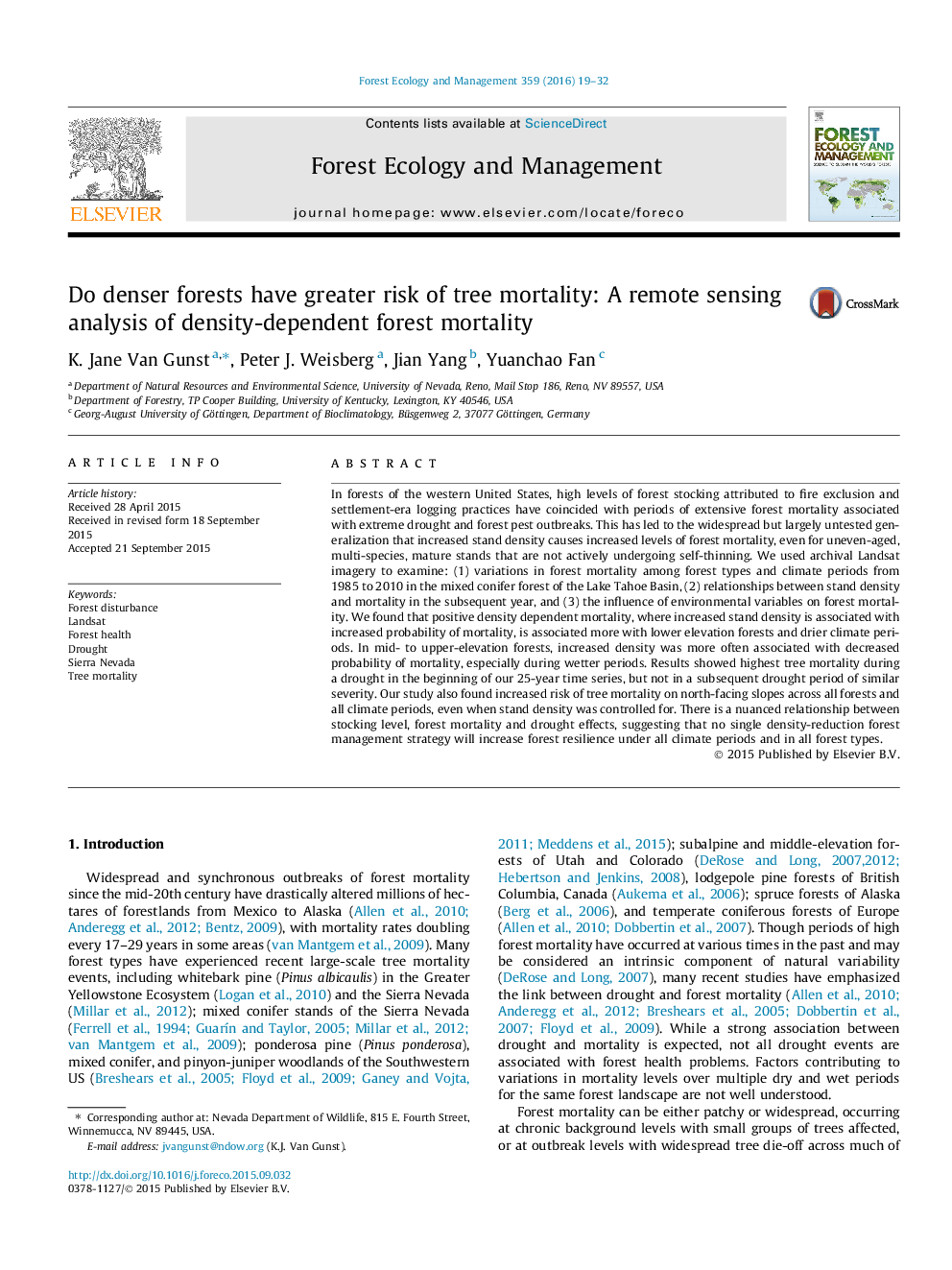| کد مقاله | کد نشریه | سال انتشار | مقاله انگلیسی | نسخه تمام متن |
|---|---|---|---|---|
| 6542613 | 159164 | 2016 | 14 صفحه PDF | دانلود رایگان |
عنوان انگلیسی مقاله ISI
Do denser forests have greater risk of tree mortality: A remote sensing analysis of density-dependent forest mortality
ترجمه فارسی عنوان
جنگلهای چگال بیشتر خطر مرگ و میر درختان را دارند: یک تحلیل سنجش از راه دور از مرگ و میر جنگل وابسته به تراکم
دانلود مقاله + سفارش ترجمه
دانلود مقاله ISI انگلیسی
رایگان برای ایرانیان
کلمات کلیدی
اختلال جنگل، لندست، سلامت جنگل، خشکی، سیرا نوادا، مرگ و میر درخت،
ترجمه چکیده
در جنگل های غربی ایالات متحده، سطح بالایی از جنگلداری به علت خروج آتش سوزی و فعالیت های جنگل های دورافتاده با دوره های مرگ و میر جنگل گسترده همراه با شیوع آفات خشکسالی و جنگل ها همخوانی دارد. این منجر به تعمیم گسترده، اما تا حد زیادی تست نشده است که افزایش تراکم بوته باعث افزایش سطح مرگ و میر جنگل ها، حتی برای ناهموار، چند گونه، بالغ بالغ که به طور فعال تحت خود ریزش نیست. از تصاویر آرشیوی لندست برای بررسی موارد زیر استفاده شد: (1) تغییرات در مرگ و میر جنگل در میان انواع جنگل ها و دوره های آب و هوایی از سال 1985 تا 2010 در جنگل های مخروط مخلوط دریاچه تاهو، (2) روابط بین چگالی ایستاده و مرگ و میر در سال بعد، و (3) تاثیر متغیرهای محیطی بر مرگ و میر جنگل. ما دریافتیم که مرگ و میر وابسته به چگالی مثبت، جایی که تراکم ایستاده افزایش می یابد با افزایش احتمال مرگ و میر همراه است، بیشتر با جنگل های کم ارتفاع و دوره های هوای خشک تر مرتبط است. در اواسط تا جنگل های بلند، تراکم بیشتر در اغلب موارد با کاهش احتمال مرگ و میر، به ویژه در دوره های مرطوب مرتبط بود. نتایج نشان داد که بیشترین مرگ و میر درختان طی خشکسالی در ابتدای سری زمانی 25 ساله ما، اما نه در دوره بعدی خشکسالی با شدت مشابه. همچنین مطالعه ما همچنین افزایش خطر مرگ و میر درختان در دامنه های شمال را در تمام جنگل ها و تمام دوره های آب و هوایی، حتی زمانی که چگالی ایستاده به آن کنترل شد، افزایش داد. بین سطح انبارداری، مرگ و میر جنگلی و اثرات خشکسالی ارتباطی پراکنده وجود دارد که نشان می دهد که هیچ استراتژی مدیریت جنگلداری با کاهش تراکم تنها افزایش مقاومت جنگل را در تمام دوره های آب و هوایی و در تمام انواع جنگل افزایش می دهد.
موضوعات مرتبط
علوم زیستی و بیوفناوری
علوم کشاورزی و بیولوژیک
بوم شناسی، تکامل، رفتار و سامانه شناسی
چکیده انگلیسی
In forests of the western United States, high levels of forest stocking attributed to fire exclusion and settlement-era logging practices have coincided with periods of extensive forest mortality associated with extreme drought and forest pest outbreaks. This has led to the widespread but largely untested generalization that increased stand density causes increased levels of forest mortality, even for uneven-aged, multi-species, mature stands that are not actively undergoing self-thinning. We used archival Landsat imagery to examine: (1) variations in forest mortality among forest types and climate periods from 1985 to 2010 in the mixed conifer forest of the Lake Tahoe Basin, (2) relationships between stand density and mortality in the subsequent year, and (3) the influence of environmental variables on forest mortality. We found that positive density dependent mortality, where increased stand density is associated with increased probability of mortality, is associated more with lower elevation forests and drier climate periods. In mid- to upper-elevation forests, increased density was more often associated with decreased probability of mortality, especially during wetter periods. Results showed highest tree mortality during a drought in the beginning of our 25-year time series, but not in a subsequent drought period of similar severity. Our study also found increased risk of tree mortality on north-facing slopes across all forests and all climate periods, even when stand density was controlled for. There is a nuanced relationship between stocking level, forest mortality and drought effects, suggesting that no single density-reduction forest management strategy will increase forest resilience under all climate periods and in all forest types.
ناشر
Database: Elsevier - ScienceDirect (ساینس دایرکت)
Journal: Forest Ecology and Management - Volume 359, 1 January 2016, Pages 19-32
Journal: Forest Ecology and Management - Volume 359, 1 January 2016, Pages 19-32
نویسندگان
K. Jane Van Gunst, Peter J. Weisberg, Jian Yang, Yuanchao Fan,
